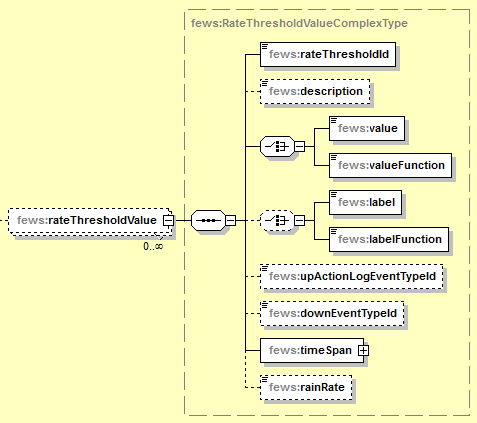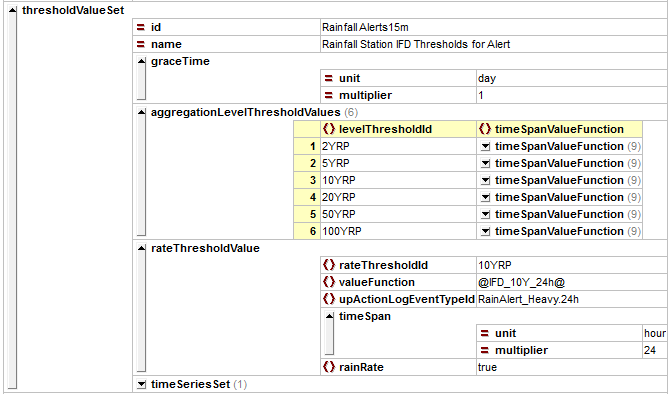| scrollbar |
|---|
<p><br /></p> |
What | ThresholdValueSets.xml |
|---|---|
Required | no |
Description | definition of threshold values for all locations and data types |
schema location | httphttps://fewsfewsdocs.wldelftdeltares.nl/schemas/version1.0/thresholdValueSets.xsd |
| Table of Contents |
|---|
Complementary to the definition of the types of thresholds identified, the values of the thresholds are defined in the ThresholdValueSets configuration (ThresholdValueSets.xml on a local filesystem).
...
EventTypeIds (otherwise known as EventCodes) are used as a prefix in logging messages for the MC to identify which threshold is crossed. When threshold messages need to be logged, a special predefined threshod activity is required in the workflows.
| Code Block | ||||||
|---|---|---|---|---|---|---|
| ||||||
<levelThresholdValue> <levelThresholdId>UKV</levelThresholdId> <valueFunction>1</valueFunction> <upActionLogEventTypeId>UKVRRCThreshold.crossed</upActionLogEventTypeId> </levelThresholdValue> |
ThresholdValueSet Schema
The latest version of the ThresholdValueSet schema can be found on the Deltares schema site: http://fews.wldelft.nl/schemas/version1.0/thresholdValueSets.xsd. The elements in the schema are shortly described below.
...
One or more qualifier ids the used rating curve should have all
ThresholdValueSetSequence
...
Specific values for max thresholds.
levelThresholdValue
levelThresholdId
...
ID of the action message (=additional log.message) that must be logged if a threshold value is crossed DOWN. This id has to contain a dot, because the action event is only visible to the master controller if this id contains a dot, e.g. "Threshold_Name.Down". The event code need not be unique.
rateThresholdValue
rateThresholdId
...
An event threshold value is similar to a level threshold, only it has the possibility to be based on correlation events. See 07 Correlation Module - EOL in 2023#07CorrelationModule-LocationAttributeBasedEvents
The advantage to this is that for instance peak heights that occured through the years can be used in the correlation display as well as a threshold without storing the same information in different ways.
The <parameterIdFunction> specifies for which parameter the threshold is valid, the enabled function specifies whether the it should be included as threshold or not. This is mainly meant to filter out events needed for the correlation module that is not desired as threshold. This functionality is specifically designed for multivalued attributes. An important requirement is that for all the functions: <valueFunction>, <labelFunction>, <parameterIdFunction> and <enabledFunction> the location should have the same amount of attribute values.
This can easily be accomplished by storing all attributes in the same multivalued attribute csv file like the example below.
function is optional, when not configured the thresholds will be applied to all parameters of the timeseries associated with the threshold value set. When multiple different parameters are present in a plot in the Time Series Dialog and it is desired that the event thresholds are visible it might be needed to duplicate the attribute values for the different parameters because there will be no thresholds shown when multiple time series have thresholds which are not identical. When this duplicate configuration is undesired it might be better to remove this function.
The <enabledFunction> can refer to a boolean location attribute which specifies whether the event should be included as threshold or not. Default is false.
This functionality is specifically designed for multivalued attributes. An important requirement is that for all the functions: <valueFunction>, <labelFunction>, <parameterIdFunction> and <enabledFunction> the location should have the same amount of attribute values.
This can easily be accomplished by storing all attributes in the same multivalued attribute csv file like the example below.
| Code Block | ||||
|---|---|---|---|---|
| ||||
<thresholdValueSet id="EventThresholds" name="EventThresholds">
<eventThresholdValues> | ||||
| Code Block | ||||
| ||||
<thresholdValueSet id="EventThresholds" name="EventThresholds"> <eventThresholdValues> <eventThresholdId>LevelWarn</eventThresholdId> <valueFunction>@PEAK_HEIGHT_VALUE@</valueFunction> <labelFunction>@PEAK_HEIGHT_TIME@</labelFunction> <parameterIdFunction>@PEAK_HEIGHT_PAR@</parameterIdFunction> <enabledFunction>@PEAK_HEIGHT_ENABLED@</enabledFunction> </eventThresholdValues> <timeSeriesSet> <moduleInstanceId>ThresholdCheck</moduleInstanceId> <valueType>scalar</valueType> <parameterId>H.m<<eventThresholdId>LevelWarn</parameterId>eventThresholdId> <locationSetId>MultiValuedAttributeThresholds</locationSetId><valueFunction>@PEAK_HEIGHT_VALUE@</valueFunction> <timeSeriesType>external historical</timeSeriesType><labelFunction>@PEAK_HEIGHT_TIME@</labelFunction> <timeStep unit="hour" divider="1" multiplier="1"/><parameterIdFunction>@PEAK_HEIGHT_PAR@</parameterIdFunction> <readWriteMode>add originals</readWriteMode><enabledFunction>@PEAK_HEIGHT_ENABLED@</enabledFunction> </timeSeriesSet> </thresholdValueSet>eventThresholdValues> <timeSeriesSet> <moduleInstanceId>ThresholdCheck</moduleInstanceId> <valueType>scalar</valueType> <parameterId>H.m</parameterId> <locationSetId>MultiValuedAttributeThresholds</locationSetId> <timeSeriesType>external historical</timeSeriesType> <timeStep unit="hour" divider="1" multiplier="1"/> <readWriteMode>add originals</readWriteMode> </timeSeriesSet> </thresholdValueSet> |
| Code Block | ||||
|---|---|---|---|---|
| ||||
<?xml version="1.0" encoding="UTF-8"? | ||||
| Code Block | ||||
| ||||
<?xml version="1.0" encoding="UTF-8"?> <!-- edited with XMLSPY v5 rel. 4 U (http://www.xmlspy.com) by Juzer Dhondia (WL | Delft Hydraulics) --> <!--Sample XML file generated by XMLSPY v5 rel. 4 U (http://www.xmlspy.com)--> <locationSets xmlns="http://www.wldelft.nl/fews" xmlns:xsi="http://www.w3.org/2001/XMLSchema-instance" xsi:schemaLocation="http://www.wldelft.nl/fews httphttps://fewsfewsdocs.wldelftdeltares.nl/schemas/version1.0/locationSets.xsd" version="1.1"> <locationSet id="MultiValuedAttributePeakHeights"> <csvFile> <file>MultiValuedAttributePeakHeightsLocations.csv</file> <geoDatum>WGS 1984</geoDatum> <id>%ID%</id> <name>%NAME%</name> <x>%X%</x> <y>%Y%</y> <z>0</z> <attributeFile> <csvFile>MultiValuedAttributePeakHeightsLocationAttributes.csv</csvFile> <id>%ID%</id> <dateTimePattern>dd-MM-yyyy</dateTimePattern> <attribute id="PEAK_HEIGHT_PAR"> <text>%PAR%</text> </attribute> <attribute id="PEAK_HEIGHT_TIME"> <dateTime>%TIME%</dateTime> </attribute> <attribute id="PEAK_HEIGHT_VALUE"> <number>%VALUE%</number> </attribute> <attribute id="PEAK_HEIGHT_ENABLED"> <boolean>%ACTIVE%</boolean> </attribute> </attributeFile> </csvFile> </locationSet> </locationSets> |
...
is used to log the info that the related forecast run was available within a certain time window when the observed threshold has been crossed.
deprecatedConversionChoice
...
The aggregationLevelThresholdValues are used in the Spatial Display. When the accumulation slider computes new aggregated values, the correct thresholdvalue will be used for the aggregated time period.


